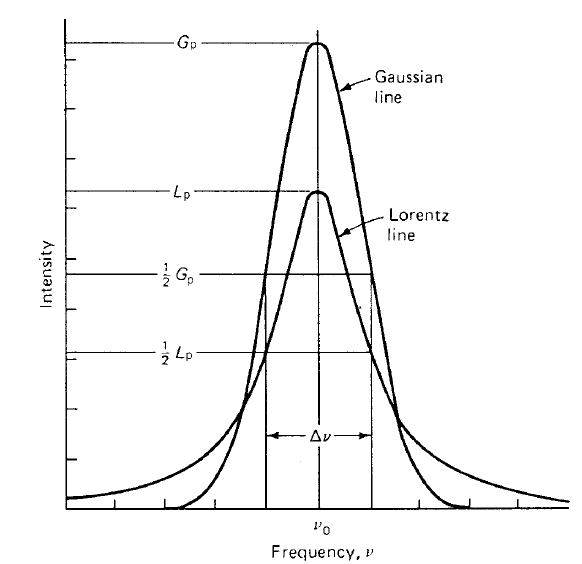
The Inhomogeneously Broadened Line
 المؤلف:
Walter Koechner Michael Bass
المؤلف:
Walter Koechner Michael Bass
 المصدر:
Solid-state Lasers
المصدر:
Solid-state Lasers
 الجزء والصفحة:
23
الجزء والصفحة:
23
 26-1-2021
26-1-2021
 1830
1830
The Inhomogeneously Broadened Line
Mechanisms which cause inhomogeneous broadening tend to displace the center frequencies of individual atoms, thereby broadening the overall response of a collection without broadening the response of individual atoms. Different atoms have slightly different resonance frequencies on the same transition, for example, owing to Doppler shifts. As a result, the overall response of the collection is broadened. An applied signal at a given frequency within the overall linewidth interacts strongly only with those atoms whose shifted resonance frequencies lie close to the signal frequency. The applied signal does not have the same effect on all the atoms in an inhomogeneously broadened collection.
Since, in an inhomogeneously broadened line, interaction occurs only with those atoms whose resonance frequencies lie close to the applied signal frequency, a strong signal will eventually deplete the upper-laser level in a very narrow frequency interval. The signal will eventually “burn a hole” in the atomic absorption curve. Examples of inhomogeneous frequency-shifting mechanisms include Doppler broadening and broadening due to crystal inhomogeneities.
Doppler Broadening. The apparent resonance frequencies of atoms undergoing random motions in a gas are shifted randomly so that the overall frequency response of the collection of atoms is broadened. A particular atom moving with a velocity component ν relative to an observer in the z-direction will radiate at a frequency measured by the observer as ν0(1 + v/c). When these velocities are averaged, the resulting lineshape is Gaussian. Doppler broadening is one form of inhomogeneous broadening since each atom emits a different frequency rather than one atom having a probability distribution for emitting any frequency within the linewidth. In the actual physical situation, the Doppler line is best visualized as a packet of homogeneous lines of width �νn, which superimpose to give the observed Doppler shape. The He–Ne laser has a Doppler-broadened linewidth. Most visible and near-infrared gas laser transitions are inhomogeneously broadened by Doppler effects.
Line Broadening Due to Crystal Inhomogeneities. Solid-state lasers may be inhomogeneously broadened by crystalline defects. This happens only at low temperatures where the lattice vibrations are small. Random variations of dislocations, lattice strains, and so forth, may cause small shifts in the exact energy level spacings and transition frequencies from ion to ion. Like Doppler broadening, these variations do not broaden the response on an individual atom, but they do cause the exact resonance frequencies of different atoms to be slightly different. Thus random crystal imperfection can be a source of inhomogeneous broadening in a solid-state laser crystal.
A good example of an inhomogeneously broadened line occurs in the fluorescence of neodymium-doped glass. As a result of the so-called glassy state, there are variations, from rare earth site to rare earth site, in the relative atomic positions occupied by the surrounding lattice ions. This gives rise to a random distribution of static crystalline fields acting on the rare earth ions. Since the line shifts corresponding to such crystal-field variations are larger, generally speaking, than the width contributed by other factors associated with the transition, an inhomogeneous line results.
The inhomogeneous-broadened linewidth can be represented by a Gaussian frequency distribution. For the normalized distribution, the equation

FIGURE 1. Gaussian and Lorentz lines of common linewidth (Gp and Lp are the peak intensities).
 .....(1)
.....(1)
is valid, where ν0 is the frequency at the center of the line and Δν is the linewidth at which the amplitude falls to one-half. The peak value of the normalized Gaussian curve is
 ......(2)
......(2)
In Fig. 1 the normalized Gaussian and Lorentz lines are plotted for a common linewidth.
 الاكثر قراءة في مواضيع عامة في الليزر
الاكثر قراءة في مواضيع عامة في الليزر
 اخر الاخبار
اخر الاخبار
اخبار العتبة العباسية المقدسة


